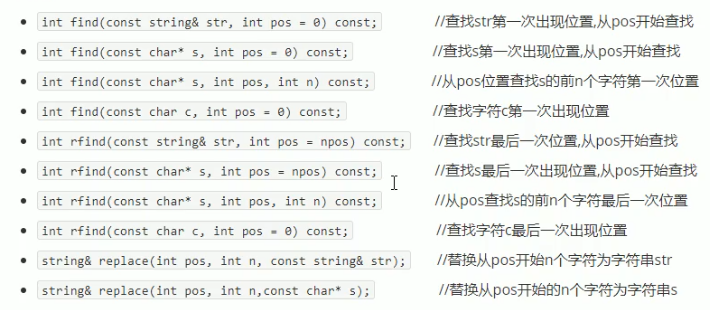STL容器——string
1.string容器
本质:string是C++风格的字符串,但是string本质是一个类,string字符串的第一个字符位置为0。
区别string和char*:
char*是一个指针。
string是一个类,类内有char*,有一个char*的容器来管理这个字符串(string)
优:
string类内部封装了很多成员方法,像是:查找find,拷贝copy,删除delete,替换replace,插入insert等。
同时string管理char*分配的内存,无需担心复制越界或是取值越界等问题,这些均有string类内部自主处理。
①string是一个类,他的一些构造函数如下:
●string(); //创建一个空的字符串,例如:string str;
string(const char* s); //用字符串s来初始化
●string(const string& str); //用一个string对象初始化另一个string对象
●string(int n, char c); //使用n个字符c,来初始化
1 #include <iostream> 2 #include <string> 3 using namespace std; 4 5 void test1(){ 6 string s1; 7 8 const char* str = "hello world"; 9 string s2(str); 10 cout << "s2=" << s2 << endl; 11 12 string s3(s2); 13 cout << "s3=" << s3 << endl; 14 15 string s4(10 ,'a'); 16 cout << "s4=" << s4 << endl; 17 } 18 19 int main(){ 20 test1(); 21 system("pause"); 22 return 0; 23 }
②string的赋值:
作用:给字符串赋值啊。。
赋值的函数原型如下:
● string& operator= (const char* s); //char*类型字符串 赋值给当前的字符串
● string& operator= (const string &s); //把字符串s赋值给当前字符串
● string& operator= (char c); //用字符串赋值给当前的字符串
● string& assign(const char* s); //把字符串s赋值给当前字符串
● string& assign(const char* s, int n); //把字符串的前n个字符赋值给当前字符串
● string& assign(const string &s); //把字符串s赋值给当前字符串
● string& assign(int n, char c); //用n个字符c赋值给当前字符串
例子:
1 #include <iostream> 2 #include <string> 3 4 using namespace std; 5 6 //operator=的三个例子 7 void test01(){ 8 string str1; 9 str1 = "nihao"; 10 cout << "str1=" << str1 << endl; 11 12 string str2; 13 str2 = str1; 14 cout << "str2=" << str2 << endl; 15 16 string str3; 17 str3 = 'a'; 18 cout << "str3=" << str3 << endl; 19 } 20 21 //assign的四个例子 22 void test02(){ 23 string str4; 24 str4.assign("wow,hhh"); 25 cout << "str4=" << str4 << endl; 26 27 string str5; 28 str5.assign("ab,cdef",3); 29 cout << "str5=" << str5 << endl; 30 31 string str6; 32 str6.assign(str4); 33 cout << "str6=" << str6 << endl; 34 35 string str7; 36 str7.assign(5,'h'); 37 cout << "str7=" << str7 << endl; 38 } 39 40 int main(){ 41 //test01(); 42 test02(); 43 system("pause"); 44 return 0; 45 }
③string字符串拼接:
作用:在字符串末尾拼接字符串。。
函数原型如下:
● string& operator+= (const char* str); //重载+=,在当前字符串后面连接新的字符串
● string& operator+= (const char c); //重载+=,在当前字符串后面增加一个字符c
● string& operator+= (const string& str); //重载+=,在当前字符串后面连接另一个字符串
● string& append(const char *s); //把字符串s连接到当前字符串结尾
● string& append(const char *s, int n); //把字符串s的前n个字符连接到当前字符串结尾
● string& append(const string &s); //同string& operator+= (const string& str);
● string& append(const string &s, int pos, int n); //字符串s中从pos开始的n个字符连接到当前字符串结尾
例子:
1 #include <iostream> 2 #include <string> 3 using namespace std; 4 5 //operator 6 void test01(){ 7 string str1 = "你好你好"; 8 str1 += ",哈哈哈"; 9 cout << "str1= " << str1 << endl; 10 11 string str2 = "wowow"; 12 str2 += 'c'; 13 cout << "str2= " << str2 << endl; 14 15 string str3 = "ooo"; 16 str3 += str1; 17 cout << "str3= " << str3 << endl; 18 } 19 20 //append 21 void test02(){ 22 string str4 = "hh"; 23 str4.append("66666"); 24 cout << "str4= " << str4 << endl; 25 26 string str5 = "324"; 27 str5.append("abc,defg",4); 28 cout << "str5= " << str5 << endl; 29 30 string str6 = "nihao:"; 31 str6.append(str4); 32 cout << "str4= " << str4 << endl; 33 34 string str7 = "mmm"; 35 str7.append("123456",3,2); 36 cout << "str7= " << str7 << endl; 37 } 38 39 int main(){ 40 // test01(); 41 test02(); 42 system("pause"); 43 return 0; 44 }
④string查找和替换:
作用:
1.查找:查找指定字符串是否存在(有就返回相应的值[切记位置由字符串开头为1开始往后数,无论你指定第几个开始查找],没有就返回-1)
2.替换:在指定位置替换字符串
函数原型如下:

区别find和rfind:find是从左往右查找,rfind是从右往左查找。。
例子:
1 #include <iostream> 2 #include <string> 3 using namespace std; 4 //查找 5 void test1(){ 6 string str1 = "012345678910"; 7 int a = str1.find("10",5); //无论从第几个位置开始找,总会返回从字符串开头到指定字符串的位置的值(10),而非从第5个字符开始,就返回5 8 cout << "a= " << a <<endl; 9 10 int b = str1.rfind("10"); 11 cout << "b= " << b <<endl; 12 } 13 //替换 14 void test2(){ 15 string str2 = "hi,gg!"; //6个字符 16 str2.replace(3, 2,"world"); //从第3个后面开始的2个字符(gg),替换为world 17 cout << "str2= " << str2 << endl; 18 } 19 20 int main(){ 21 // test1(); 22 test2(); 23 system("pause"); 24 return 0; 25 }
⑤string字符串比较:
作用:比较字符串(按ASCII码来进行比较,等于返回0,大于返回1,小于返回-1)。。
在中文中,比较大小主要用来检测两个字符串是否相等,大小没有什么意义。
函数原型如下:

例子:
1 #include <iostream> 2 #include <string> 3 using namespace std; 4 5 void test(){ 6 string s1 = "bi"; 7 string s2 = "bi"; 8 string s3 = "ai"; 9 string s4 = "ci"; 10 11 int a = s1.compare(s2); 12 int b = s1.compare(s3); 13 int c = s1.compare(s4); 14 15 //在abc的ASCII中a值最小,b居中,c最大 16 cout << "a= " << a <<endl; 17 cout << "b= " << b <<endl; 18 cout << "c= " << c <<endl; 19 } 20 21 int main(){ 22 test(); 23 system("pause"); 24 return 0; 25 }
⑥string单个字符存取:
对于string的单个字符存取有两种方式:

也可以通过此种方式修改字符串里面的某个字符。。
例子:
1 #include <iostream> 2 #include <string> 3 using namespace std; 4 5 void test(){ 6 string s = "hello"; 7 for(int i = 0; i < s.size() ; i++){ 8 cout << s[i] << endl; 9 } 10 for(int i = 0; i < s.size() ; i++){ 11 cout << s.at(i) << endl; 12 } 13 14 s[0] = 'x'; 15 s.at(4) = 'w'; 16 cout << "s= " << s << endl; 17 } 18 19 int main(){ 20 test(); 21 system("pause"); 22 return 0; 23 }
⑦string的插入和删除:
作用:字面意思。。
函数原型如下:

例子:
1 #include <iostream> 2 #include <string> 3 using namespace std; 4 5 void test(){ 6 string s1 = "hello"; 7 s1.insert(2,"wow"); //从第2个字符后开始插入wow 8 cout << "s1= " << s1 << endl; 9 10 string s2 = "hi"; 11 s2.insert(1,s1); //从第1个字符后开始插入字符串s1 12 cout << "s2= " << s2 << endl; 13 14 s1.erase(3,4); 15 cout << "s1= " << s1 << endl; 16 } 17 18 int main(){ 19 test(); 20 system("pause"); 21 return 0; 22 }
⑧string子串:
作用:从字符串中获取指定的字串。
函数原型:string substr(int pos = 0, int n = npos) const; //返回由pos开始的n个字符组成的字符串
人话:新的字符串名字 = 原字符串名字.substr(pos,npos);






【推荐】国内首个AI IDE,深度理解中文开发场景,立即下载体验Trae
【推荐】编程新体验,更懂你的AI,立即体验豆包MarsCode编程助手
【推荐】抖音旗下AI助手豆包,你的智能百科全书,全免费不限次数
【推荐】轻量又高性能的 SSH 工具 IShell:AI 加持,快人一步
· winform 绘制太阳,地球,月球 运作规律
· AI与.NET技术实操系列(五):向量存储与相似性搜索在 .NET 中的实现
· 超详细:普通电脑也行Windows部署deepseek R1训练数据并当服务器共享给他人
· 【硬核科普】Trae如何「偷看」你的代码?零基础破解AI编程运行原理
· 上周热点回顾(3.3-3.9)